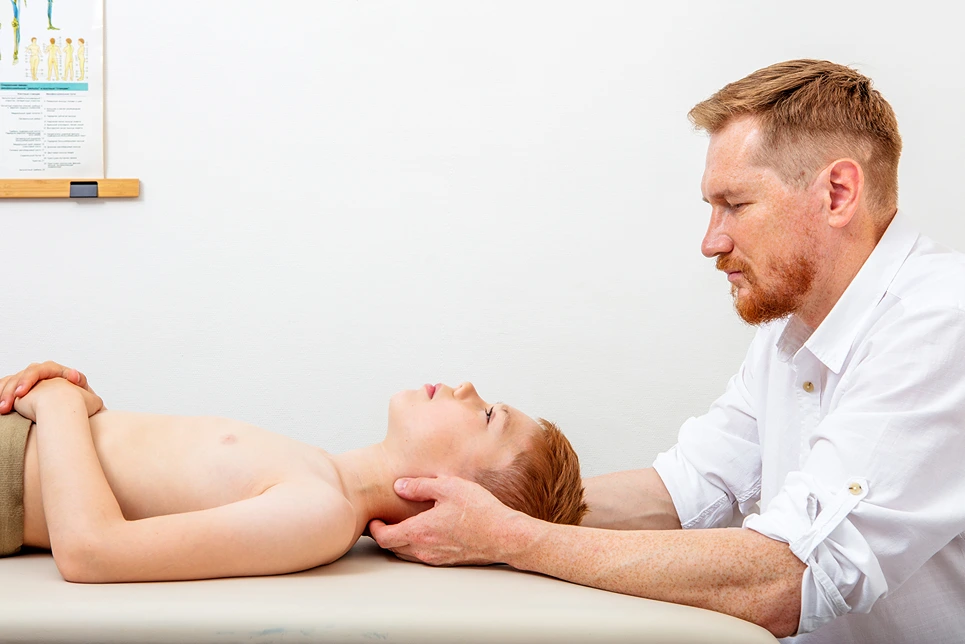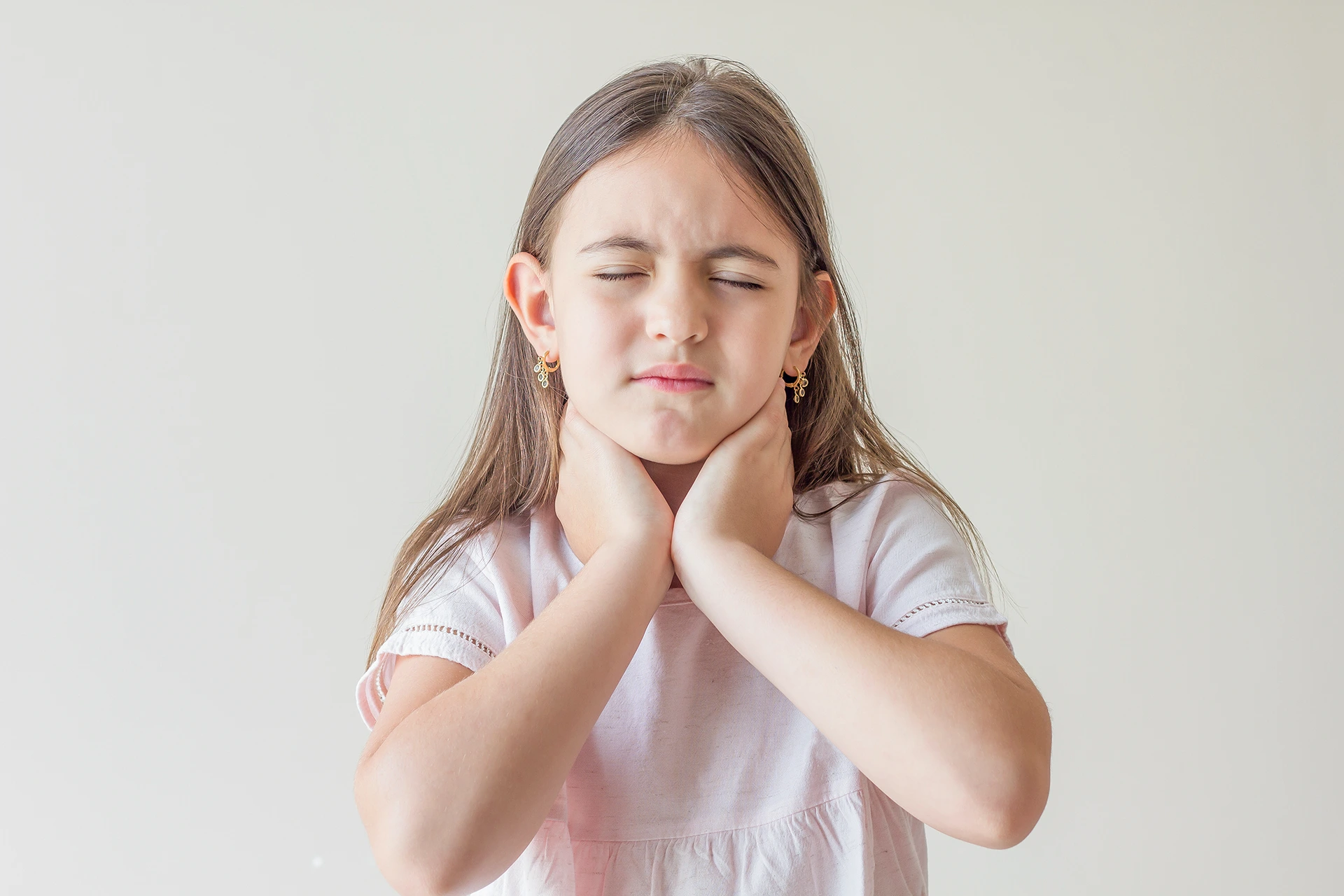Does your child complain of neck pain but doesn’t have a fever? Neck pain in children without a fever can stem from various causes. While it usually isn’t serious, it’s always best to identify the source of the pain and take appropriate steps for relief and prevention.
Help your child find relief from neck pain. Trust Kaly to connect you with experts for accurate diagnosis and treatment.
Common Causes of Neck Pain in Children Without Fever

Children can experience neck pain for various reasons unrelated to infection or illness. Understanding these common causes can help in identifying and addressing the issue effectively.
Muscle Strain
Children, much like adults, can suffer from muscle strains in their neck. This often occurs due to overuse injuries or maintaining the same head position for extended periods, such as during reading or using electronic devices.
These activities can lead to muscle tightness or spasms. Additionally, sleeping in an uncomfortable position might also contribute to neck muscle strain.
Minor Injuries
Active play and sports, common in childhood, can lead to minor injuries causing neck pain. Falls or bumps affecting the head, neck, or shoulders, and even sudden movements like those experienced on a rollercoaster, can result in soft tissue damage and consequent neck discomfort.
Poor Posture
Improper posture is a significant contributor to neck pain in children. Slouching, hunching over screens, and incorrectly carrying backpacks put undue strain on the neck and upper back.
As children’s muscles are still developing, maintaining proper posture can be challenging, especially after long hours of sitting at school.
Stress and Anxiety
Children’s psychological well-being can have physical manifestations, including neck pain. Stress and anxiety can cause children to unconsciously tense their neck and shoulder muscles, leading to discomfort. It’s crucial to ensure a supportive environment for children to manage these psychological stressors.
Sleeping Position
The position in which a child sleeps can affect their neck health. An awkward sleeping posture can strain neck muscles, leading to stiffness and pain upon waking.
When Should You Seek Medical Care for a Child’s Neck Pain?
Mild neck pain often resolves on its own with rest and gentle stretching. But talk to your pediatrician if your child experiences:
- Severe or persistent pain lasting more than 1 week
- Pain interfering with sleep or daily activities
- Difficulty moving the neck
- Numbness/tingling in arms or hands
- Headache, nausea or vomiting along with neck pain
- Injury such as trauma to the spine or head
Platforms like Kaly provide quick access to pediatricians, physical therapists, and other specialists to assess neck pain and rule out serious conditions. Don’t hesitate to seek medical advice, especially if your child’s symptoms seem unusual or severe.
Home Remedies for Soothing Children’s Sore Necks

Gentle home care can be quite effective in alleviating mild neck pain in children. Here are some strategies to consider:
Rest and Immobilization
Encourage your child to take a break from strenuous activities and limit movements that might aggravate the neck pain. For added support and to prevent further strain, a soft neck brace or collar can be beneficial. This approach helps stabilize the neck muscles and joints.
Cold and Heat Therapy
Initially, apply a cold pack to the affected area for short intervals. This helps reduce swelling and numbness discomfort. After a day or two, switch to gentle heat application using a heated pad or a warm towel. Heat therapy relaxes the muscles and improves circulation, aiding in quicker recovery.
Over-the-Counter Pain Medication
For immediate pain relief, children’s versions of ibuprofen or acetaminophen can be effective. It’s important to follow the age-appropriate dosage instructions to avoid any side effects. These medications not only relieve pain but also reduce inflammation.
Gentle Massage and Stretching
A light massage in the neck and shoulder area can stimulate blood flow and ease muscle tension. Additionally, teaching your child simple neck stretches can improve flexibility and strength, preventing future neck issues.
Good Posture and Ergonomics
Proper posture plays a crucial role in preventing neck strain. Ensure that your child’s workstation is ergonomically set up, with the chair and desk at the correct height, feet flat on the floor, and screens at eye level. Limiting time spent on phones and tablets also helps maintain good neck posture.
Avoid aggressive manipulation of the neck which could worsen pain and inflammation. Maintain a close watch on symptoms, and contact your pediatrician if pain persists beyond a week.
Don’t let your child’s neck pain go unchecked. Use Kaly to easily access top specialists for a thorough evaluation.
What Medical Conditions Can Cause Neck Pain in Kids?
While rare, some underlying medical conditions can cause neck pain in children. These include:
Meningitis
This dangerous infection of the membranes surrounding the brain and spinal cord usually presents with fever, headache, and stiff neck along with other flu-like symptoms. Meningitis requires immediate medical attention.
Juvenile Arthritis
Chronic inflammation of the joints affecting kids and teens can manifest as neck pain and stiffness, along with swelling and tenderness in other joints like the knees or hands.
Lyme Disease
Neck pain can occur in the early stages of this tick-borne illness, along with the telltale “bullseye” rash. Flu-like symptoms, fatigue and headaches may develop later.
Infections
This primarily involves common infections like viral infections, pharyngitis, and laryngitis. These conditions can cause the lymph nodes in the neck area to become inflamed, leading to neck pain.
Spinal Infection
This is a more specific and severe condition where the infection directly affects the cervical spine – the bones, discs, or tissues of the neck. Spinal infections can cause inflammation, damage to the bone structure, and neck pain. In some cases, abscesses can form around the spine, leading to nerve compression and additional pain or neurological symptoms.
Congenital Spinal Abnormalities
Some children are born with conditions that affect the integrity of their spinal structure, which might predispose them to issues like disc herniation or early disc degeneration.
Underlying Medical Conditions
Certain genetic disorders or systemic diseases can affect the health of the spine and increase the risk of these conditions in children.
Though less common, alert your doctor about any family history of arthritis or autoimmune conditions that may contribute to neck pain in your child. Regular well-child visits allow early diagnosis and treatment of any developing problems.
Pediatric Specialists: Evaluating Children’s Neck Pain
When a child experiences persistent, severe, or unusual neck pain, pediatric specialists play a crucial role in diagnosis and treatment.
Pediatric Neurologists
These specialists focus on nerve function and can conduct advanced imaging tests such as CT scans, MRIs, or ultrasounds. They are equipped to uncover any underlying spinal or neurological issues that might be causing the neck pain.
Pediatric Orthopedists
Orthopedic specialists in pediatrics assess the structure and alignment of the spine, as well as any injuries that might be causing symptoms. Their expertise is invaluable in addressing the structural causes of neck pain.
Pediatric Rheumatologists
Rheumatologists specialize in inflammatory and autoimmune conditions, such as juvenile arthritis, which can cause neck pain. They are skilled in prescribing treatments to manage inflammation and prevent joint damage.
Kaly provides a convenient way to find the appropriate specialist for your child’s needs. Their providers offer comprehensive services, including telehealth consultations, referrals for in-person care, and coordinated ongoing care.
Impact of Lifestyle Factors and Activities on Children’s Neck Pain

Children’s daily habits and activities significantly influence their neck health. Understanding and adjusting these aspects can help alleviate or prevent neck pain:
Screen Time
Excessive use of computers, tablets, and smartphones can lead to poor neck posture, where the head is tilted forward, and shoulders are hunched. This position strains neck muscles and the spine. It’s important to limit screen time according to age-appropriate guidelines and encourage breaks to stretch and adjust posture.
Backpack Use
Heavy backpacks, especially if worn improperly, exert pressure on the neck and shoulders. Ensure your child uses both shoulder straps and the backpack’s weight doesn’t exceed 10-15% of their body weight. Pack it evenly to prevent imbalanced loading.
Sports and Recreation
Activities like football, gymnastics, or weightlifting can put stress on the neck, especially with poor technique or inadequate safety gear. Emphasize the use of appropriate protective equipment and proper form to reduce the risk of neck strain.
Stress and Sleep
The demands of school, social life, and lack of adequate sleep can lead to chronic stress in children, often manifesting as neck tension. Encourage healthy coping strategies and good sleep habits to alleviate stress-induced neck pain.
Diet and Nutrition
A balanced diet is crucial for developing strong bones, muscles, and ligaments that support spinal health. Ensure your child consumes a diet rich in calcium, vitamin D, and other essential nutrients for optimal musculoskeletal development.
By making these lifestyle adjustments and providing neck-friendly accessories, such as ergonomic chairs and supportive pillows, you can significantly reduce the strain on your child’s neck.
Physical Therapy and Exercises for Children’s Neck Pain
How Physical Therapy Helps
Physical therapy is an effective approach for managing persistent or recurring neck pain in children. Pediatric physical therapists specialize in exercises and techniques specifically tailored for young patients, aiming to reduce pain and strengthen the neck area.
Techniques Used in Physical Therapy
- Gentle Mobilization: Involves guided movements to improve spinal joint mobility, enhancing flexibility and reducing stiffness.
- Stretching: Targeted stretches are designed to relax tight neck muscles, increasing range of motion and providing relief.
- Postural Exercises: Focus on strengthening the neck, upper back, shoulders, and core muscles, crucial for maintaining proper posture.
- Traction: Gentle, sustained pulling on the neck to alleviate muscle tightness and discomfort.
- Massage: Hands-on techniques to release muscle tension and soothe sore areas.
Customized Home Exercise Programs
Pediatric physical therapists also develop personalized home exercise programs that include stretches and strengthening exercises, emphasizing gentle execution and proper form to prevent further injury.
Access Top Specialists Through Kaly

Whether it’s for physical therapy or other pediatric care needs, Kaly provides a straightforward solution for parents seeking prompt and professional assessment and treatment for their child’s neck pain.
Our network includes highly-rated general practitioners, orthopedists, neurologists, and physical therapists who specialize in children’s health, all accessible via convenient telehealth services.
Trust Kaly to connect you with the right experts for effective and timely care for your child.
